Carbon Dioxide Removal (CDR) Technology
A Deeper Look
Carbon reWork is a technology-agnostic company dedicated to championing effective and sustainable solutions for engineered carbon dioxide removal CDR, encompassing a range of technologies designed to actively extract carbon dioxide (CO2) from the atmosphere.These technologies play a crucial role in combating climate change by reducing the concentration of greenhouse gasses and mitigating their negative effects.
Direct Air Capture (DAC):
Direct Air Capture is a prominent CDR method that involves capturing CO2 directly from the ambient air. DAC systems typically use chemical sorbents or specialized filters to bind with CO2 molecules. Once captured, the CO2 is separated and can be stored or utilized for various purposes.
DAC Methods
- Chemical Absorption: This method utilizes liquid solvents or solid sorbents to chemically bind with CO2. The CO2-rich solution is then heated or treated to release the captured CO2, which can be further processed.
- Adsorption: Similar to absorption, adsorption involves the use of solid materials with a high surface area to trap CO2 molecules on their surface. The captured CO2 is then released through changes in temperature or pressure.
- Membrane Filtration: Special membranes are employed to selectively filter out CO2 molecules from the air. The CO2 is then concentrated and extracted for further use or storage.
Using Captured CO2 for Concrete Production:
Captured CO2 can be effectively utilized in concrete production, a process known as CO2 mineralization. The captured CO2 reacts with calcium or magnesium silicates present in concrete, forming stable carbonate minerals. This mineralization process not only sequesters CO2 but also enhances the strength and durability of concrete.
Benefits of Adding Captured Carbon Dioxide to Concrete
Permanent Carbon Storage: Transforms CO2 into stable carbonate minerals, effectively locking it away.
Enhanced Durability: Increases concrete’s flexibility and resistance to cracking.
Reduced Production Costs: Requires 10-20% less cement, the most expensive concrete component.
Lower Carbon Footprint: Reduces CO2 emissions associated with cement production, generating carbon credits.
Contributes to a Circular Economy: Provides a sustainable use for captured CO2, promoting a closed-loop system.
Pioneering Carbon Removal Solutions
Carbon reWork is breaking down the barriers to make ECDR at scale a reality by championing effective and sustainable solutions through a technology-agnostic approach. We are passionate about exploring and implementing diverse, cutting-edge technologies that leverage renewable energy sources. By embracing this multi-faceted strategy, we can accelerate progress and lead the way in deploying carbon removal solutions to combat climate change.
Geological Sequestration
Geological sequestration, also known as carbon capture and storage (CCS), is a proven technology that offers a significant pathway to combat climate change. In essence, it involves capturing carbon dioxide (CO2) emissions from industrial sources or directly from the atmosphere and safely storing them deep underground in geological formations. This prevents the release of CO2 into the atmosphere, where it contributes to global warming.
How it Works
The geological sequestration process starts with capturing CO2 emissions, either directly from industrial sources or through innovative technologies like Direct Air Capture. Once captured, the CO2 is purified and compressed into a supercritical fluid state for easier transport and injection. It’s then injected through a carefully designed well into deep geological formations, typically located more than a mile underground.
Once injected, the CO2 is securely trapped within the formation through multiple mechanisms. A natural, impermeable rock layer called a caprock acts as a seal, preventing upward escape. Additionally, the CO2 becomes trapped within the rock’s tiny pores, dissolves into the formation’s brine, and over time, reacts with minerals to form solid carbonate minerals, ensuring its permanent storage.

Different Storage Methods
- Hydrodynamic Trapping: An impermeable layer of rock, called a caprock, acts as a natural seal, preventing the CO2 from escaping upwards.
- Residual Trapping: The CO2 becomes trapped within the tiny pores of the rock, similar to water being absorbed by a sponge.
- Solubility Trapping: The CO2 dissolves into the salty water (brine) naturally present in the formation, increasing its density and preventing upward migration.
- Mineral Trapping: Over time, the CO2 reacts with minerals in the rock, forming solid carbonate minerals and becoming a permanent part of the rock formation.
The Benefits
Significant CO2 Reduction: Geological sequestration has the potential to capture and store massive amounts of CO2, significantly reducing greenhouse gas emissions and helping to mitigate climate change.
Proven Technology: The technology has been successfully used for decades, with a strong track record of safety and effectiveness.
Climate Change Reversal: By removing CO2 from the atmosphere, geological sequestration can contribute to reversing the effects of climate change and protecting the planet for future generations.
Long-Term Storage: The CO2 remains securely stored underground for thousands of years, offering a long-term solution for carbon emissions management.
Scalable Solution: The technology can be implemented at various scales, from individual industrial facilities to large-scale carbon capture and storage hubs.
Geological sequestration presents a hopeful and viable solution for addressing the urgent challenge of climate change. By harnessing the power of the Earth, we can capture and store CO2 emissions, paving the way for a more sustainable and resilient future.
Large-Scale Carbon Removal Plants
Large-Scale Carbon Removal Plants
Renewable and Low Carbon Energy Integration
Renewable and Low Carbon Energy Integration
CO2 Conversion
CO2 Conversion
Sustainable Future
Sustainable Future
Carbon Credit Investment
Carbon Credit Investment
Carbon reWork is a leading innovator
in implementing cutting-edge technologies to effectively address climate change. We are developing large-scale carbon removal plants that combine Direct Air Capture (DAC) methods with renewable energy sources to capture and utilize CO2, turning a harmful greenhouse gas into a valuable resource.
By investing in carbon credits, individuals and businesses can directly contribute to the expansion of these transformative plants, accelerating the path towards a greener, healthier planet and securing a sustainable future for all.
